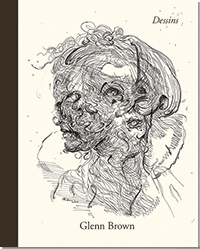
|
|
|||
Glenn Brown: Dessins French / English 28 x 35 cm 68 pages 30 color illustrations 978-3-935567-80-0 out of print
|
This is the first publication focusing on the drawings of British artist Glenn Brown. Far from mere studies or sketches, they are artworks in their own right. Brown starts with reproductions of Old Masters, quoting and disassembling them, picking up the pieces and transmuting them. Often he will change the orientation of a motif or layer several details one over the other. The lines, drawn with a simple fineliner, meander between silhouette, ornament, volume, and image noise, growing many-headed figurative metamorphoses. An essay by Andreas Schalhorn, curator for modern and contemporary art at the Kupferstichkabinett in Berlin, closely follows this process, during which portrait studies or ascensions from the hand of a Rubens or Murillo, Boucher or Greuze, or a foot by Menzel, grow into uncanny forms that offer a fitting expression for today’s fragmented image of humanity.
CALCULATION AND PASSION Overall one gains the impression that the artist must have retreated deep into the study room, immersing himself into the universe of print and drawing collections. In Paris, where these drawings are presented for the first time at Galerie Max Hetzler, the internationally renowned Department of Prints and Drawings at the Louvre comes to mind, which holds many treasures from the hand of the aforementioned artists. In London, where Glenn Brown lives, he may have visited the equally famous Department of Prints and Drawings at the British Museum. (And the author of these lines may be permitted to add to this grouping the collection of prints and drawings at the Kupferstichkabinett of the Staatliche Museen zu Berlin, for which he works as a curator.) Yet contrary to that impression, Brown – in his drawings as in his paintings – does not directly study and adapt the originals but rather reproductions from art books. This becomes evident in the inscription on Drawing 23 (after Boucher) (2014). On the left margin of the paper, the artist signed and dated the work in ink and then added the inscription ‘Boucher 694 Seated Nude Great Drawings of All Time III’, referring to the four-volume Great Drawings of All Time, edited by art historian Ira Moskowitz and published in 1962 in New York. It is by the French Rococo painter François Boucher, executed in red chalk with heightenings in white, and it depicts, as Brown notes on his work, a female nude sitting on an imaginary cloud... Brown has translated Boucher’s work, building on the tone and colour gradations inherent in the use of red chalk, into a composition of black lines presented on an almost clinically white background. The choice of paper is remarkable here. Instead of a conventional drawing paper, Brown often uses sheets made from polypropylene. It is a synthetic and, in this case, transparent material with an exceptionally smooth, easy-to-print-on surface and therefore common in advertising. Its use in an art context is therefore noteworthy, even if artists have produced drawings on a range of artificial papers especially since the 1960s. Brown draws on polypropylene sheets of various sizes with a fine liner and lightfast ink, resulting in homogeneous lines. This drawing instrument does not allow him to achieve lines that notably swell and shrink in width, as could a quill pen. To emphasize the outline and shades of Boucher’s female figures, Brown simply places lines more closely together. Throughout, Brown refrains from the gestures of the Old Masters in his drawings. He is no copyist who merely traces his templates like a slave. When he gradually appropriates the motif and style of a given drawing, or more precisely, its reproduction, the source receives a new reinterpretation. The body of the nude in Brown’s drawing based on Boucher appears to be coated with a second, porous skin, which almost appears to be tattooed, due to the complex use of cropped lines. The face, in contrast, seems to dissolve almost fully. To achieve these occasionally morbid transformations, derived from one or several templates, Brown often draws on both sides, or several sheets, of the transparent polypropylene... The interaction between individual motifs, perspectives or image fragments results in irritating, almost surreal interferences characteristic of these painstakingly developed line drawings.
... In collaboration with Galerie Max Hetzler Berlin | Paris |